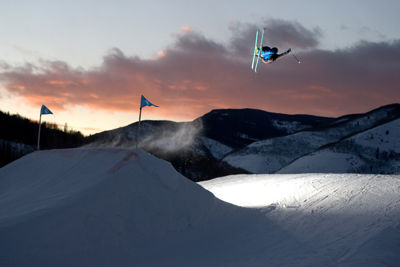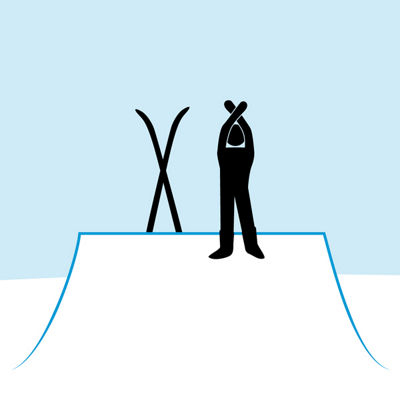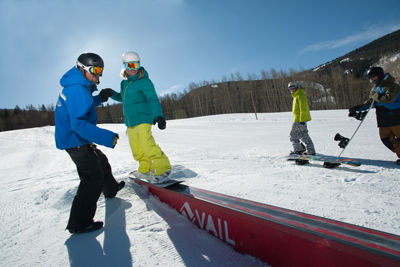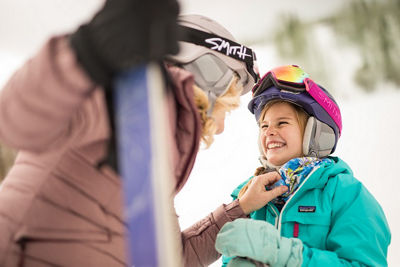EVERY FEATURE. EVERY TIME.
MAKE A PLAN
Always use the Terrain Park Mantra: Pre-ride, Re-ride, Free-ride
Things happen fast in this sport. Stack the deck in your favor with a plan—envisioning everything you need to do—and visualize yourself doing it successfully.
- Preview terrain before you attempt it, as it can often be difficult to see the entire story from upslope. Take a warm up lap and scope the features (i.e. go around the jumps first, not over them).
- Your speed, approach, and takeoff directly affect both your tricks and your landing. If someone else hits the feature before you, see what speed works for them. Be aware that features constantly change throughout the day due to weather, usage, grooming, and time of day.
- Take the time to read signs and heed hazard markers and flags.
- Use a spotter. They can see new hazards (like an unaware skier entering the feature incorrectly). If you crash, they can signal to those above you to wait.
...Before You Leap
Gather what information you can from signage, warnings, and other park riders. A closed sign, roped-off features, a pair of crossed skis or poles, bamboo, or any object blocking the entrance can all indicate that a feature is closed.
Before you drop into a feature, take a cruiser warm-up lap through the park. Because features evolve due to weather, usage, and time of day, something you hit yesterday or even a few minutes ago may look (or ride) totally different than it does at this moment.
Respect Gets Respect
So there’s a line? We get it— paradise would be a private halfpipe for only you and your friends—but use this time to your advantage. Watch others’ speed and tricks to see what you can learn. Be positive, and watch the stoke spread.
- Respect others: give those who were waiting before you a chance to drop. When it’s your turn, call your drop, making a clear verbal call or signal (read on for more info below).
- Respect Park Crew: stay off closed features. Park Crew works hard to sculpt features for you to ride, and features that are currently closed are shut down for a reason: they’re only going to get better!
Take it Easy
Ready for a few hot laps through the park? To make the most of your time, keep these points in mind:
- Practice the tricks you can already nail before moving on to bigger variations.
- Try new variations of your tricks on small features before moving to large features.
- Start on (or close to) the ground, and move up from there. For example, working on your backside 360? Try spinning on the ground, and then a smaller jump before you move onto a big tabletop.
Remember that freestyle skills are all about control, whether you’re on the ground or in the air. Your abilities and experience dictate your ability to land a trick. And please note, because inverted aerials increase your risk of injury, we don’t recommend them.
Make this lap one more of many, and take it easy. Trust us: you won’t regret it.
Call Your Drop
It’s almost go time! Just as respect is key in all aspects of park riding, so too is calling your drop. You’ve seen it in ski and snowboard movies: what is it that every pro does before launching?
They call it.
Signal you’re going next by raising one arm in the air and calling out that you’re going as you slowly move forward towards the feature.
How to Close a Feature
Sometimes the best efforts still end in a crash: help others out by signaling when someone has fallen. Close the jump by doing the following:
- Stand your skis in the snow vertically (so they are sticking up out of the snow) in an X shape. If you have a snowboard, do the same (but you’ll make just a capital I). Position your gear so that riders coming from above can clearly see that the jump is closed (i.e. at the highest point of the takeoff).
- Physically block the feature if someone else is attending to the injured skier/rider.
- Call Ski Patrol if necessary.









